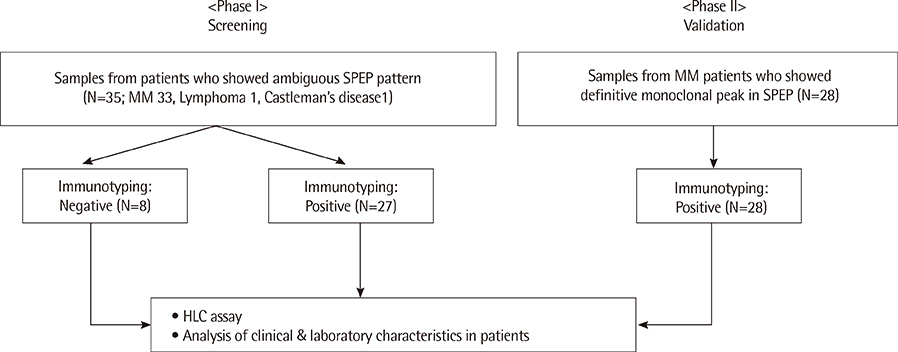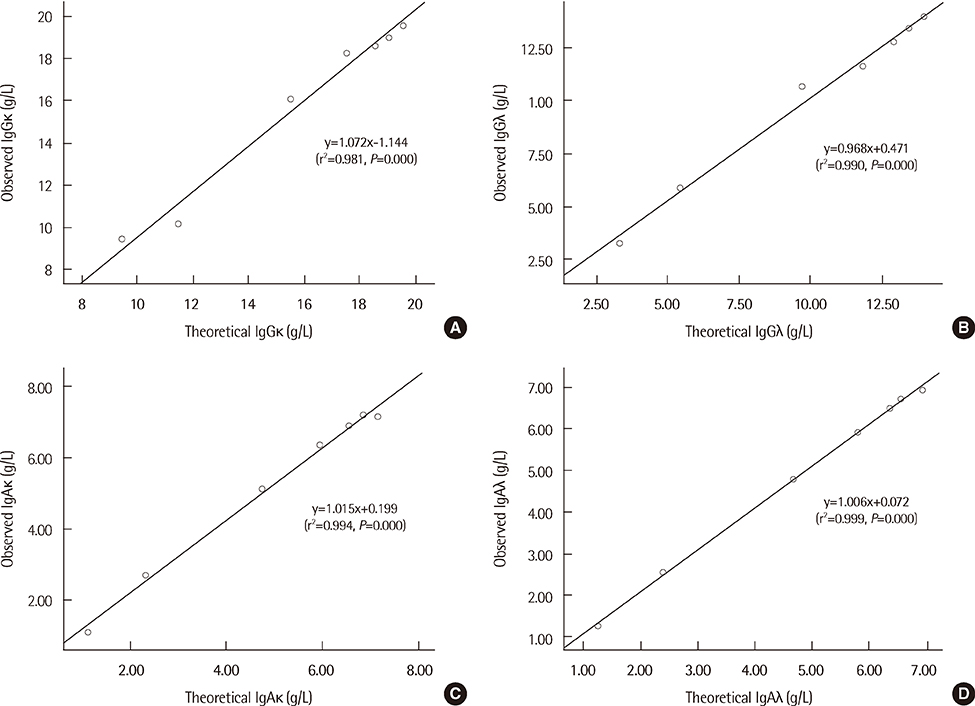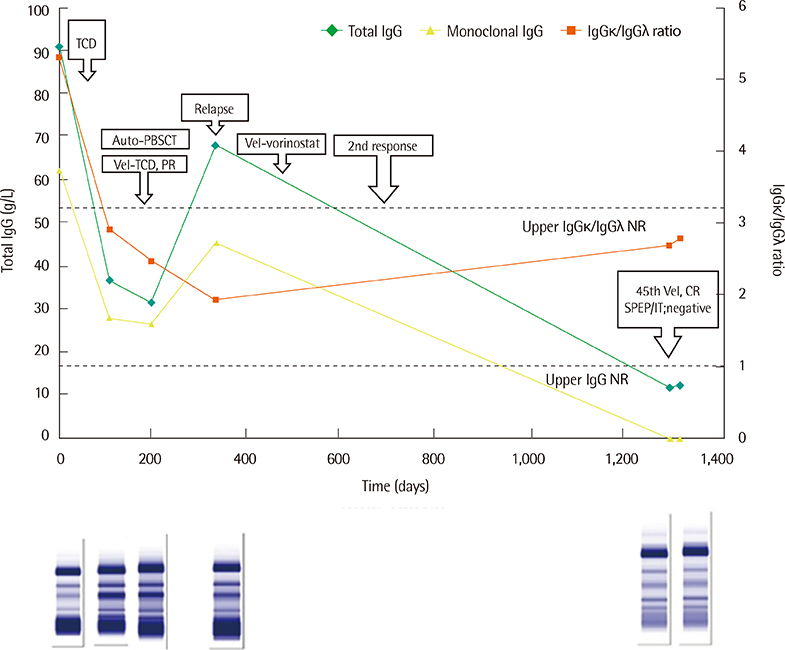Lab Med Online.
2014 Jan;4(1):28-35.
Direct Measurement of Serum Immunoglobulin Heavy and Light Chain Pairs for Identification of Monoclonal Gammopathy and a Performance Comparison with Capillary Electrophoresis
- Affiliations
-
- 1Department of Laboratory Medicine, Chonnam National University Hwasun Hospital, Hwasun, Korea. mgshin@chonnam.ac.kr
- 2Department of Clinical Pathology, Gwangyang Health College, Gwangyang, Korea.
- 3Brain Korea 21 Project, Center for Biomedical Human Resources, Chonnam National University, Gwangju, Korea.
- 4Department of Laboratory Medicine, Chonnam National University Medical School, Gwangju, Korea.
Abstract
- BACKGROUND
Determination of monoclonal gammopathy through conventional protein electrophoresis is sometimes difficult because of the presence of large proteins such as haptoglobin and transferrin, which may obscure the results. Ambiguity in an electrophoresis band can give rise to confusion or difficulty in interpretation. The heavy chain/light chain assay (HLC assay) using Hevylite antibody (The Binding Site, UK) has recently been developed for the accurate measurement of monoclonal proteins. We compared the immunotyping (IT) profiles to the immunoglobulin (Ig) heavy/light chain measurements obtained using the HLC assay and observed the ratios between intact Ig kappa and lambda.
METHODS
We collected 35 and 28 sera from patients with suspicious and definitive monoclonal protein, respectively. Then we performed serum protein electrophoresis (SPEP) and IT by Capillarys2 (Sebia, USA). Monoclonal protein production was investigated using Freelite antibody (The Binding Site) and specific Ig(G, A)kappa and Ig(G, A)lambda Hevylite antibodies. The results were analyzed using PASW 18.0 for Windows (IBM, USA).
RESULTS
Direct measurement of Ig heavy/light chains showed discordant IT results for 12 (34.2%) of 35 patients' sera with suspicious SPEP pattern and identical IT results for 28 patients' sera with definitive monoclonal peak in the SPEP results. Overall, the results of the HLC assay and IT showed good agreement (kappa=0.718, P=0.000 by cross-tabulation Gamma, Kappa analysis).
CONCLUSIONS
The results of direct measurement of serum Ig heavy chain/light chain pairs were comparable to those of IT and were helpful for determination of monoclonality in the case of ambiguous electrophoresis results. Measurement of the heavy chain/light chain pair ratio also allowed precise quantification of the monoclonal Igs with ambiguous electrophoresis patterns and identification or discrimination of clonality.
MeSH Terms
Figure
Reference
-
1. Hortin GL. Amino acids, peptides, and proteins. In : Burtis CA, Ashwood ER, Bruns DE, editors. Tietz textbook of clinical chemistry and molecular diagnostics. 5th ed. Missouri: ELSEVIER Saunders;2012. p. 509–563.2. McPherson RA, Massey HD. Laboratory evaluation of immunoglobulin function and humoral immunity. In : McPherson RA, Pincus MR, editors. Henry's clinical diagnosis and management by laboratory methods. 22th ed. Philadelphia: ELSEVIER Saunders;2011. p. 899–913.3. Legg A, Harding S, Hughes RG, Levoguer AM, Bradwell AR. Serum free light chain and Hevylite analyses in the diagnosis, monitoring and prognosis of B cell disorders. Klin biochem metab. 2010; 18:56–61.4. Yang Z, Harrison K, Park YA, Chaffin CH, Thigpen B, Easley PL, et al. Performance of the Sebia CAPILLARYS 2 for detection and immunotyping of serum monoclonal paraproteins. Am J Clin Pathol. 2007; 128:293–299.
Article5. McCudden CR, Mathews SP, Hainsworth SA, Chapman JF, Hammett-Stabler CA, Willis MS, et al. Performance comparison of capillary and agarose gel electrophoresis for the identification and characterization of monoclonal immunoglobulins. Am J Clin Pathol. 2008; 129:451–458.
Article6. Bradwell AR, Harding SJ, Fourrier NJ, Wallis GL, Drayson MT, Carr-Smith HD, et al. Assessment of monoclonal gammopathies by nephelometric measurement of individual immunoglobulin kappa/lambda ratios. Clin Chem. 2009; 55:1646–1655.
Article7. Katzmann JA, Clark RJ, Abraham RS, Bryant S, Lymp JF, Bradwell AR, et al. Serum reference intervals and diagnostic ranges for free kappa and free lambda immunoglobulin light chains: relative sensitivity for detection of monoclonal light chains. Clin Chem. 2002; 48:1437–1444.
Article8. Lee JH, Bang SM. Epidemiological change of multiple myeloma in Korea. Korean J Hematol. 2006; 41:225–234.
Article9. Kang SY, Suh JT, Lee HJ, Yoon HJ, Lee WI. Establishment of serum reference range for free light chains and its clinical usefulness in multiple myeloma. Korean J Lab Med. 2004; 24:273–278.10. Keren DF. Heavy/Light-chain analysis of monoclonal gammopathies. Clin Chem. 2009; 55:1606–1608.
Article11. Tovar N, Fernández de Larrea C, Elena M, Cibeira MT, Aróstegui JI, Rosiñol L, et al. Prognostic impact of serum immunoglobulin heavy/light chain ratio in patients with multiple myeloma in complete remission after autologous stem-cell transplantation. Biol Blood Marrow Transplant. 2012; 18:1076–1079.
Article
- Full Text Links
- Actions
-
Cited
- CITED
-
- Close
- Share
- Similar articles
-
- Monoclonal gammopathy of renal significance from the perspective of nephrologists
- Discrimination of Monoclonal Gammopathy Using Immunoassay for Free Light Chains
- Evaluation of the Screening Tests for the Diagnosis of Plasma Cell Neoplasm
- Technical Considerations and Miscellaneous Findings on Electrophoretograms of Serum Protein Capillary Electrophoresis
- Seven Cases of Monoclonal Gammopathies Involving Kidney




